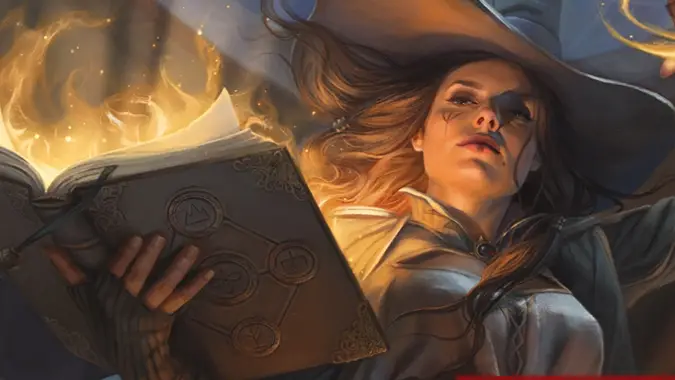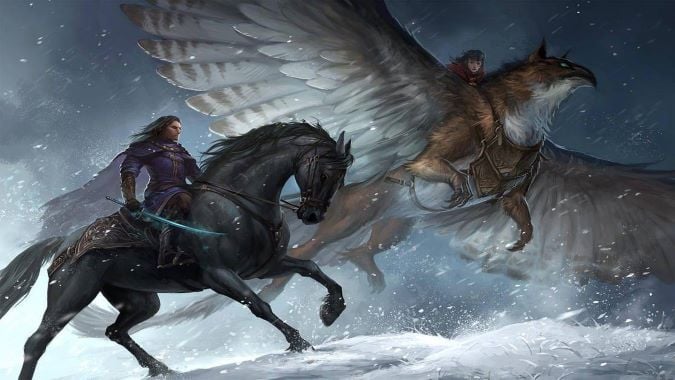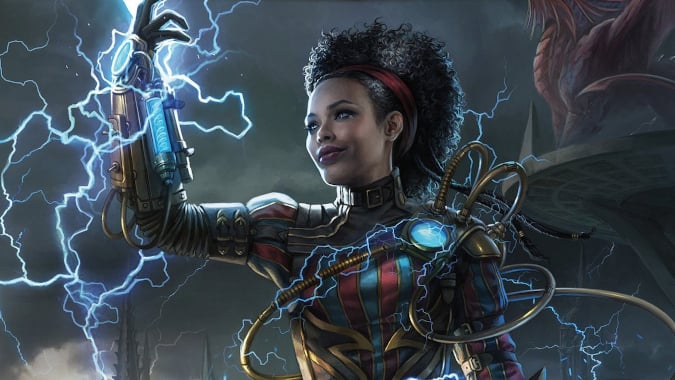New subclasses in Tasha’s Cauldron of Everything bring new life to Dungeons and Dragons

One of the best parts of the brand new Tasha’s Cauldron of Everything that’s just come out for the 5th Edition of Dungeons and Dragons are the subclasses it offers. Furthermore, because the creators of Tasha’s are aware of how many of the people who would love to take advantage of the book and its new subclasses are currently well into campaigns on characters who have already taken a subclass, the book comes with a new rule that lays out a process for a Dungeon Master to let their players change their subclass — so if you’ve been playing as an Eldritch Knight Fighter but the Rune Knight sounds like more of what you had in mind, you can switch to the new subclass.
This is something that’s been a house rule for quite a few games out there now, and it’s grand to see it get made an official rule in this manner, because there are a lot of subclasses in Tasha’s and it would be painful for players to be unable to get to play with them. There are 29 new subclasses in this book, ranging from the Warlock’s Genie patron to the Cleric’s Order domain, and we’re going to talk about all of them.

The scholarly subclasses: Bards, Clerics, Wizards, and Artificers
Artificer subclasses
For the Artificer, the subclasses on offer in Tasha’s are presented along with the class itself, updated to be a more generalized character class instead of the Eberron specific one we’ve seen previously. Accompanying that are four subclasses.
- The Alchemist, who uses magical potions and elixirs to channel their powers
- The Armorer, inhabiting a heavy suit of Plate and animating and powering it with raw arcane might — think a magepunk Iron Man
- The Artillerist, who likes to make things explode at a distance even more than you’d think from the name.
- The Battle Smith, who creates and maintains a construct as a pet and defense in battle
Of these four subclasses the Armorer has the most interesting flavor in my opinion, and goes the furthest towards a kind of battle-mage archetype we haven’t seen very often in D&D, that could be reskinned to be pure technology fairly easily in a science fiction campaign if you were so inclined. And if you like the idea of having a robot pet that follows you around hitting things, Battle Smith will let you do that exact thing.
Bard subclasses
Bards get two subclasses as well, the College of Creation and the College of Eloquence. The College of Creation is a more esoteric option, with powers that amplify Bardic abilities such as Inspiration and weave subtle effects over creation itself, while the College of Eloquence is amazing if you end up having to be the party face a lot, as it gives you new options for various Charisma based checks and abilities.
Cleric subclasses
Clerics get three new Domains, the Order, Peace and Twilight Domains. Of these, the Order Domain has some interesting synergy for a group of players, while the Peace Domain is good for a Cleric who wants to manifest the idea of working to bring peace, not necessarily just the having of it, and the Twilight Domain is about exploring liminal spaces and existing on the boundary between darkness and light.
Wizard subclasses
Our Wizard friends are deciding between Bladesinging, a magical tradition of song and stabbing that makes them feel a bit like bards but more focused on the singing and stabbing, and the Order of Scribes, which leans hard into that whole ‘we love books, we love reading, we’re the nerds of D&D and we’re going to use it to kill you’ aesthetic that Wizards have going on. Of the two, the Order of Scribes just feels more fundamentally Wizard to me, but all of these subclasses are pretty awesome, and you could do a lot with Bladesinger if you wanted a more weapon oriented spellcaster who didn’t lose out on the Wizard’s higher level spells.

Did someone say Chaotic Neutral? Druid, Barbarian, and Ranger subclasses lean into the wild
Druid subclasses
Druids, you get to pick between the Circle of Spores, a fungus based approach that trades away Wild Shapes for a fungal infection that grants extra health for them to use while spellcasting as well as some interesting fungus zombies, the Circle of Stars, which lets you battle (or commit) evil by Starlight with a Starry Form, and the Circle of Wildfire which is basically about how awesome fire is and how it’s totally okay to burn everything, ultimately.
Barbarian subclasses
The Barbarian gets two subclasses, the Path of the Beast and the Path of Wild Magic. Of the two, the Path of the Beast is a lot easier to use, and it basically makes you an unarmed Barbarian, doing damage with your monstrous changed form — think of them almost like Wolverine from the X-Men, going berserk and lashing out with their claws. Wild Magic is a neat concept but it doesn’t end up as compelling for Barbs, in my opinion.
Ranger subclasses
Rangers get the Few Wanderer and the Swarmkeeper options. Fey Wanderers are tied to the Feywild and the mystical, unearthly aspect of the wilds, while Swarmkeepers… look, there’s no fancy way to say this, they like swarms of things. Rather than one big animal companion, Swarmkeepers summon a cloud of insects to be their helpers in combat and companion outside of it. Of the two, the Swarmkeeper has some serious potential but I personally prefer the Fey Wanderer, especially for its Dreadful Strikes class feature adding psychic damage which is among the few damage types that almost no creature has resistance to.

Monk, Rogue, and Fighter subclasses teach you how to punch people in unexpected ways
Monk subclasses
Monks get the Way of Mercy and the Way of the Astral Self, which means choosing between punching people in a way that heals them or a way that harms them and becoming one with their Astral Selves, which unsurprisingly doesn’t mean they hit you less — instead, they can summon two additional arms from their Astral Self to punch you with even more.
Rogue subclasses
For Rogues, there’s the Phantom, who changes things up with ghostly powers like learning skills from the dead, inflicting necrotic damage on a target when you sneak attack another target, and eventually walking through walls. The Soulknife, like the Psychic Warrior, can summon their mind’s inner power but they use that power to create a psychic blade to stab people with. Both are cool, but I’d give the edge in utility to the Phantom, ultimately.
Fighter
For Fighters, the options are the Psychic Warrior who channels the inner power of the mind, and the Rune Knight, who through carving magical runes on their gear can summon shackles of flame or grow to giant size, which is just cool as all heck and is probably my favorite subclass in this book.

Pact or Oath, Paladin, Sorcerer, and Warlock subclasses meddle with forces larger than themselves
Paladin subclasses
The Paladin subclasses are the Oath of Glory, which is literally swearing an oath to win in the end and do amazing things that will make you famous and beloved, and the Oath of the Watchers, which eschews things like that for the whole guarding the prime material plane from demons and other extra planar invaders thing. Of the two, I think the Oath of the Watchers is a better all-around option, especially when a demon shows up.
Sorcerer subclasses
Sorcerers gain the choice between the Aberrant Mind — channeling psychic might through a blood legacy tainted by creatures from beyond — and the Clockwork Soul, which means somewhere in your family tree lies something orderly, be it a living construct like a Warforged or a extraplanar entity like a Modron. They both have fun options and are pretty excellent in terms of flavor, but I think the Aberrant Mind has slightly more punch, if you’re willing to be descended from Cthulhu or something.
Warlock subclasses
Warlocks? Pledge yourselves to a pact with either the Fathomless — a spirit of the deep waters, perhaps a strange aquatic god, monster or demon, who is most at home with the undersea realm. You’re like Aquaman if he made a deal with Poseidon or something. Or there’s the Genie, which is quite possibly the best Warlock subclass ever devised, with special abilities like bringing the whole party inside a magic lamp which, I mean, come on that’s awesome.

Choose whichever strikes your fancy!
With Tasha’s Cauldron of Everything giving you the option to pick a new subclass, it’s never been easier to experiment with your character and pick one of these excellent options. Finally, your Wizard can stab people effectively while yodeling! Your Rogue can pretend to be a ghost! Your Fighter got really tall! It’s a wonderful time to be alive.
Tasha’s is the book that’s shaking up D&D 5th Edition, and just in time when you realize that we’re six years into it — it’s absolutely time for new options like these to bring more character concepts to life, and I’m so very excited for it.
Please consider supporting our Patreon!
Join the Discussion
Blizzard Watch is a safe space for all readers. By leaving comments on this site you agree to follow our commenting and community guidelines.
 @MatthewWRossi
@MatthewWRossi




